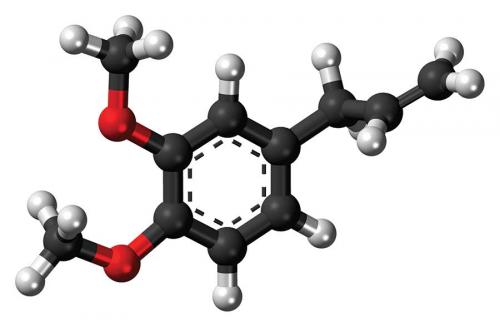This chemistry is not exactly fun – you will need to apply some serious concentration, but only a relatively small dose!
About 600 years ago, a Swiss physician, alchemist and astrologer, Philippus Aureolus Theophrastus Bombastus von Hohenheim – known to his mates (and us) as Paracelsus – founded pharmacology. He promulgated this aphorism:
The dose makes the poison. Everything is poisonous at a high enough concentration.
We can explore his statement by scanning labels on supermarket shelves. Consider clove oil. It is sometimes used in food, as an old-fashioned ingredient in pasta sauces. It’s often used in commercial products, declared as ‘flavour’.
What does the label (see photo) tell us?
Oil of cloves is good for toothache and inflamed gums. The active ingredient, eugenol, not only soothes teeth (it’s an antiseptic and analgesic; bit.ly/2QFznyN), it also sedates (it’s not sold for this purpose) and, at higher concentration, euthanises cane toads. The Australian Pesticides and Veterinary Medicines Authority is considering an application for the registration of Toad Blitz Cane Toad Killer, containing eugenol, for the humane control of cane toads in the home garden (bit.ly/2SOAo9A).
The same active ingredient is used in all of these foods and products, but why is it sometimes labelled as a poison? The difference is in the concentration. With increasing concentration, clove oil moves from being a food, to a medicine, to a cane toad killer.
The label warning in the image is for classical (acute) toxicity. It is the dose that determines this type of toxicity. For allergy, sensitivity and carcinogenic potential, the effects occur at much lower levels. Scientists agree that there is still a dose–response relationship, but it’s not linear and it’s more complicated.
We accept that taking prescribed medicines should strictly follow the dosage and don’t assume that more is better. Why not with all else?
Quinine in tonic water is a food, and as the first drug against malaria it was an effective medicine – at a certain dose. Concentrate it, and it becomes a poison on par with chemical cousins such as caffeine and, more seriously, solanine (in green potatoes).
During World War II, distinguished entomologist Doug Waterhouse was looking at ways of protecting allied troops against malaria-carrying mosquitoes in the tropics:
I tested essential oils … and an extremely effective repellent was from Huon pine … containing methyl eugenol ... To my great disappointment half of the army volunteers became nauseated within about 10 or 15 minutes after it was applied to their face. The other half … was totally unaffected …
The natural preservative in Huon pine is methyl eugenol (see structure), very widely found in nature. It is the major pheromone attractant used in traps to capture (male) papaya and oriental fruit flies, which can devastate Australia’s fruit crops, and in higher concentrations in citronella, where it repels and then kills insects. The same Paracelsus pattern.
Methyl eugenol has been assessed for the actual risk as well as theoretical hazard (potential for harm, given likely pathways of exposure). Many herbs contain low levels of methyl eugenol (e.g. basil, bay and tarragon), but using them is not considered a problem unless they are concentrated.
Most importantly, in the Australian Poisons Standard, methyl eugenol is a Schedule 6 substance and must be labelled ‘poison’ at concentrations above 1%. If such a product makes, or deems to make, a therapeutic claim, it also needs registration/listing by the Therapeutic Goods Administration, the regulatory body for therapeutic goods in Australia.
Companies using such chemicals must be registered with the National Industrial Chemical Notification and Assessment Scheme, Australia’s regulatory body for industrial chemicals. It notes unanimous agreement (including from the excellent self-regulating fragrance industry, IFRA (bit.ly/2TKV3vr)) that methyl eugenol ‘… should not be intentionally added to cosmetic products’.
Oil of cloves consists mainly of eugenol, not methyl eugenol, but both substances are classified in Schedule 6 of the Australian Poisons Standard.
Physical chemistry says that the amount of the fragrance released will increase with the surface area of the source that has been exposed and thus with decreased particle size. The release also increases exponentially with temperature. This means that solid wood is safe, while release from oil, shavings and sawdust is indeterminate. Room fresheners can ‘trigger adverse health effects’ if not strictly (self-) regulated (bit.ly/2RMmHLe). Huon pine carpet fresheners and, alarmingly, Huon-pine-stuffed teddy bears are available for sale to the public (see Jan/Feb issue, p. 5).
Hence, there is strict local and international prohibition of intentional addition of methyl eugenol to consumer products.
Some ‘health’ supplements contain concentrated extracts of natural products. Paracelsus still applies here! A few cups of green tea is fine, but some people have lost their livers after taking green tea concentrate (https://ab.co/2Rrv2o7).
So, think Paracelsus and concentrate very thoughtfully.




